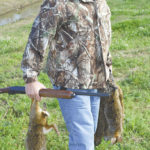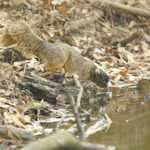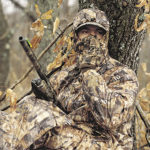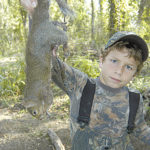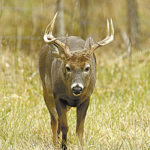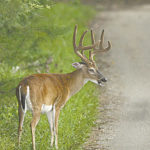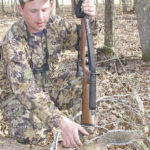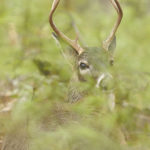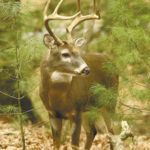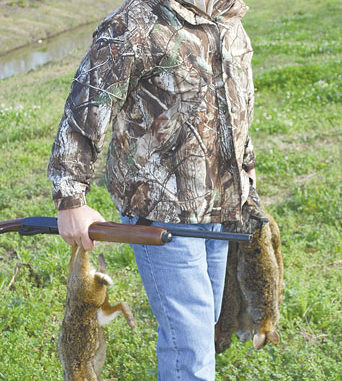
Area biologists give their picks of the public lands that will be hottest for deer, squirrels and rabbits.
Of the changes, seen and unseen, swirling around outdoors Louisiana — namely the way WMA management has been restructured in the state, and along our coast where the oil spill seeped deep into sand — there is one reassuring constant for ardent hunters in the Sportsman’s Paradise. Hunters have 1.4 million acres of public lands, both refuges and WMAs, to hunt. Those acres offer a wide variety of habitat types and give people a chance to hunt big game and small game, migratory birds, turkeys and wild hogs under the guidance of the state Department of Wildlife and Fisheries.
There are managed deer hunts each season to allow the managers a way to get the resident deer herd to a prime carrying capacity. Seasons generally are shorter on public lands than private lands because WMAs have high hunter use over less time compared to private lands.
Those are good reasons the state boasts some of the best hunting for all species on public lands in the United States. State biologists are proud of that, and countless hunters appreciate the opportunity, one they might have to do without if there weren’t so many refuges and WMAs from Bodcau in the northwest to Pass A Loutre in the southeast, from Bayou Macon in the northeast to Sabine Island in the southwest.
WMAs and refuges are being managed differently this year by the LDWF. This restructuring is an attempt to manage the properties by habitat type, not proximity to existing offices. The WMAs are now managed according to the ecoregion in which they reside, and have been divided between either the Gulf Coastal Plain (GCP) ecoregion or the Mississippi Alluvial Valley (MAV) ecoregion. The Gulf Coastal Plain ecoregion is headed by veteran biologist Czerny Newland, who contributed for many years to this annual report, the northern portion of the Mississippi Alluvial Valley ecoregion is directed by veteran biologist, Jerald Owens, another long-time contributor to this report, and the southern Mississippi Alluvial Valley ecoregion is led by Tony Vidrine, a veteran biologist who also has given insight in this report over the years.
State biologists and the WMAs or refuges they oversee in the Gulf Coastal Plains ecoregion:
• Wendell Smith in Lake Charles: Clear Creek, Fort Polk, Marsh Bayou, Peason Ridge, Sabine Island, Walnut Hills and West Bay.
• Jeffrey Johnson in Minden: Alexander State Forest, Bodcau, Bayou Pierre, Camp Beauregard, Elbow Slough, Jackson-Bienville, Loggy Bayou, Sabine, Soda Lake and Union.
• Chris Davis in Hammond: Ben’s Creek, Hutchinson Creek, Joyce, Lake Ramsey, Pearl River, Manchac, Maurepas Swamp, Sandy Hollow, Tangipahoa Parish School Board and Tunica Hills.
State biologists and the WMAs or refuges they oversee in the northern portion of the MAV:
• Charlie Booth in Monroe: Bayou Macon, Big Colewa, Floy McElroy, Ouachita and Russell Sage.
• Lowrey Moak at Buckhorn WMA northeast of Ferriday: Big Lake, Boeuf, Buckhorn and Sicily Island Hills.
State biologists and the WMAs or refuges they oversee in the southern portion of the MAV:
• Steve Smith in Pineville: Dewey Wills and Little River.
• Jonathan Bordelon in Opelousas: Attakapas Island, Elm Hall, Grassy Lake, Pomme de Terre, Red River, Sherburne, Spring Bayou, Thistlethwaite and Three Rivers.
Each of these state biologists is personable and helpful. If you have a question about one or more WMAs in a certain region, call them in Lake Charles (337) 491-2575; Minden (318) 371-3050; Hammond (985) 543-4777; Monroe (318) 343-4044; Buckhorn WMA (318) 766-8146; Pineville (318) 487-5885 and Opelousas (337) 948-0255.
The WMA managers urge hunters to check the 2010-11 Louisiana hunting pamphlet for rules and regulations pertaining to WMAs and refuges before making a trip to one of these WMAs. They also advise hunters to get out on the land and scout before the season to improve their chances to succeed.
Many state biologists have been carrying out added duties since April 20, the fateful day an explosion killed 11 men on Deepwater Horizon, an oil drilling rig 40 miles south of Venice, and resulted in a gusher of oil that spewed millions of gallons of crude oil into the Gulf of Mexico.
Chris Davis, who oversees those WMAs in Southeast Louisiana, gave his 2010-11 WMA report immediately after spending a week in the marsh around Hopedale looking for oiled birds to take to rehabilitators. Officials call him and others, generally in three-man crews that scour the marsh daily, periodically, he said.
After Hurricane Alex, the first storm of the year and a surprise one at that as fast as it built up and traveled, went into Texas, more oil was pushed into the marsh because Southeast Louisiana was on the “dirty side,” which meant storm surges and higher tides. Birds, mostly laughing gulls, flew into the marsh and got bathed in oil before being rescued by the state biologists and others looking for them in bay boats, Davis said.
Pass A Loutre WMA suffered severe oil-spill damage, according to the LDWF. Other southeastern areas were affected, as well, the state agency said.
Getting into the Louisiana Sportsman 2010-11 WMA Forecast, starting with deer in the Gulf Coastal Plain and North and South MAVs, it’s interesting to note Mother Nature played havoc with at least one popular deer hunting WMA during 2009-10.
Jeffrey Johnson, who oversees WMAs in the Gulf Coastal Plain, noted that flooding pretty much wiped out deer hunting with rifles last season at Bodcau northwest of Homer. Bodcau, which has a long either-sex rifle season, has given up consistently fair to good harvests of deer in the past, he said, but the harvest was minimal because “practically the whole area was flooded for the entire rifle season.”
Johnson predicted fair to good deer hunting on all his region’s WMAs, including Bodcau. Habitat conditions were favorable at mid-summer.
“Oh, yeah, we shouldn’t have any problems. We’re getting rain, rains last weekend and showers today — as long as we don’t get crazy floods again this year we should be in good shape,” Johnson said the second week of July. “Last year, Bodcau went like 95 percent underwater for a majority of the deer season.”
High water is a usual occurrence in the spring but rare for the fall, he said. There was a record crest on Bodcau Bayou, he said, and only one campground was open on Bodcau WMA. The animals there just moved to higher ground, he said, which meant the harvest was down because the prime huntable areas were flooded.
That act of nature bodes well for deer hunting there this season, he said.
“(Last year’s flooding) should make for a surplus of deer this year. Hopefully, we will get a really good harvest to keep this herd in check with the habitat on Bodcau WMA,” he said.
That and other areas should offer prime deer hunting. Take a look.
North MAV
Charlie Booth and Lowrey Moak, the state biologists for this region, were fired up about deer hunting possibilities, particularly after what happened last season.
Although the winter was colder than recent winters, there was no adverse impact to wildlife habitat, Booth said. He was concerned about an unusually dry spring and early summer that resulted in a nearly 10-inch rainfall deficit in the Monroe area for 2010. He realized if dry conditions continued there would be a reduction in both quality and quantity of browse plants as well as possible harm to mast production.
Deer browse was looking poor in June, he said. However, the region was experiencing normal rainfall patterns in July.
“The browse and mast, I think, will be fine,” Booth said.
The deer herd on the WMAs he oversees is in “pretty good shape,” plus he has seen numerous baby deer through early summer.
“Yeah, in fact, over the last week or so I’ve been seeing a lot of fawns and deer move. It’s basically in good shape,” he said.
Deer hunting should be good on Bayou Macon and Ouachita WMAs with Russell Sage a close second, he said. Last season the Bayou Macon deer harvest numbers were the highest reported since 2003; Russell Sage the highest reported since 1999, and Ouachita the highest reported since 2002.
“Bayou Macon has some reforested acreage with thick understory, especially south of Shrock Road, and also a lot of agricultural crops surrounding the WMA,” Booth said. “Ouachita still has a good deal of acreage reforestation, also with a thick understory. Russell Sage is 16,559 acres and composed of bottomland hardwoods with a sparse understory in most areas.”
He listed the reported harvests for Bayou Macon for archery (550 hunters, 18 deer), for primitive weapon (116 hunters, 18 deer) and modern firearm, either-sex (303 hunters, 84 deer). The reported harvests for Russell Sage for archery were 441 hunters, four deer; primitive weapons, 115 hunters, 10 deer, modern firearm-buck only, 684 hunters, 28 deer, and modern firearm, either-sex, 540 hunters, 86 deer. His list for reported harvests on Ouachita included archery (317 hunters, seven deer), modern firearm-buck only (309 hunters, 22 deer) and modern firearm, either-sex (299 hunters, six deer).
Historically, Booth said, the bigger bucks come from Bayou Macon and Russell Sage, which seem to have a little more improved habitat — reforested areas — for deer.
“During the 2009-10 WMA either-sex gun hunts for deer, three of the 20 antlered bucks taken on Bayou Macon WMA were 200 pounds or larger, one of the 25 antlered bucks taken on Russell Sage WMA was 200 pounds and Ouachita WMA produced three of 34 antlered bucks at 200 pounds or larger,” Booth said. “Bayou Macon kills some nice deer every year. I’d probably go that route if I was going to pick the top one out of the three WMAs for big deer.”
Lowrey Moak had some eye-opening numbers of his own for last season’s deer harvests via bowhunting, firearms and primitive weapons. He also predicted the best deer harvest this season would be on Buckhorn in Tensas Parish, a “very popular bottomland hardwood area (that) contains extremely thick palmetto and has the highest deer density in this part of the eco-region,” he said.
Plus, he said, “More firearm and either-sex hunting are offered on Buckhorn than any other management area in this region. These extended hunting opportunities aid in maintaining the deer herd closer to carrying capacity of this WMA.”
Also, he said, there are several weekends of youth lottery and physically challenged hunts offered on Buckhorn.
Deer harvest numbers are normally high on Boeuf, he said, but depend on timing and duration of flooding from the Boeuf River. Big Lake’s harvest will be high if hunting conditions are favorable.
Here’s how the reported deer harvest numbers stacked up on those three WMAs in 2009-10: Buckhorn WMA — 3,113 hunter efforts for 241 deer; Boeuf — 2,358 hunter efforts for 187 deer and Big Lake — 3,226 hunter efforts for 180 deer.
Want a big buck from one of his WMAs? The likelihood is there, he said.
“Big Lake most likely offers the best chance at harvesting a big deer in this part of the eco-region,” Moak said, pointing out it is a 19,000-acre-plus management area with a solid block of bottomland hardwoods that shares its eastern boundary with the 100,000-acre-plus Tensas National Wildlife Refuge.
“These two areas combined have all the essentials required to produce quality deer. Both of these management areas consistently produce multiple trophies annually,” he said.
Also, he said, try Buckhorn for a shot at a big buck. It’s filled with dense palmetto and also located near Big Lake and Tensas.
Charlie Booth said the mast crop for the WMAs he oversees looked promising. A survey will be taken later in the year, he said.
“I was looking at a red oak on Union WMA in the extreme northern part of the state, and this one was loaded with young acorns. If we keep getting enough rainfall I think (the mast crop) will be OK. I really won’t know until I get out with a pair of (binoculars) and look at the trees. If that one tree is any indication, it should look pretty good.”
Booth, a biologist supervisor who started with the state agency in 1974, pointed hopeful squirrel hunters to two areas: Russell Sage and Bayou Macon. During 2009-10, Russell Sage had 792 squirrels reported harvested by 914 hunters, while Bayou Macon saw 503 hunters take a reported 617 squirrels.
There’s no wonder he said they offer the best squirrel hunting opportunities. He did note Ouachita accounted for a reported 167 squirrels by 187 hunters.
“Both (Russell Sage and Bayou Macon) are bottomland hardwood areas with similar dominant tree species favored by squirrels. Russell Sage is larger than Bayou Macon, and it is also close to a major urban area, which increases the number of hunters on the area (particularly the first few weeks of the season),” he said, noting the majority of trees produce hard mast. “Ouachita simply does not have a large amount of squirrel habitat, and is less attractive to squirrel hunting than Russell Sage and Bayou Macon.”
Interestingly, when Booth first started working the area, Russell Sage probably was 99 percent fox squirrels, he said. Over the years, there was a transition to the point you’ll find a 50-50 mix of fox squirrels and gray squirrels.
What the state biologists did was catch some gray squirrels in Union Parish northwest of Monroe.
“We were kind of curious to see what happened, and turned them loose. I don’t know if that was a factor,” he said. “Also, in the mid-’80s, there were fairly extensive timber operations out there and those places thickened up.”
Lowrey Moak’s assessment of what lies ahead for squirrel hunters on the WMAs he oversees was a positive one
“Squirrel populations depend on the prior year’s mast crop, and this past year the crop was fair on most regional management areas,” he said in early July.
Moak expected Big Lake to have the highest squirrel harvest due to the forested habitat.
“Big Lake consists of a continuous stand of old-growth bottomland hardwoods, and is very popular among local hunters,” he said. “Boeuf rates with Big Lake in squirrel numbers and harvest, but is more subject to backwater flooding than Big Lake WMA. Buckhorn and Sicily Island Hills also contains good squirrel populations, but hunting conditions are not as favorable due to the thick palmetto on Buckhorn and the steep, rugged terrain on Sicily Island Hills.”
The reported harvest numbers from 2009-10 bear out the top squirrel hunting WMAs: Big Lake, 1,741 hunter efforts for 2,706 squirrels. Boeuf, 1,077 hunter efforts for 1,014 squirrels. Buckhorn, 252 hunter efforts for 310 squirrels.
Some of the most consistent rabbit hunting in one part of the North Mississippi Alluvial Valley is on Ouachita, Charlie Booth, biologist supervisor, said.
“The best rabbit hunting continues to be on Ouachita, primarily on the old Anderson Farm tract that was purchased in the late 1970s. This part of Ouachita has been reforested, but has a thick understory that provides quality habitat for rabbits.
“We get a lot more rabbit hunters on Ouachita. It seems to be more conducive to rabbit hunting. That’s basically where all our rabbit hunting is. Ouachita seems to hold its own as far as rabbit hunters. It’s a pretty steady number of guys who hunt out there every year.”
Russell Sage and Macon are more mature timber-type areas, an environment that is less attractive to large rabbit populations.
The reported harvest numbers bear that out after 2009-10. Based on daily self-clearing permit data submitted by rabbit hunters utilizing the WMAs, Ouachita rabbit hunters numbered 221 and bagged 115 rabbits, while Russell Sage was a distant second with 48 hunters taking four rabbits and only five rabbit hunters harvesting three rabbits on Bayou Macon.
“Simply stated, Ouachita has more rabbit habitat than the other WMAs,” Booth said.
Again, he emphasized the reforested area with its thick understory and firebreaks, which gives both cover and open areas for rabbits and hunters.
Southeast of Ouachita is another area that gives up its share of rabbits every season. That’s Boeuf, according to biologist supervisor Lowrey Moak.
“Boeuf will most likely have the highest rabbit harvest. This area is the most popular to rabbit hunters due to ease of hunting, (and the) large size of hunting area containing an abundance of rabbits,” he said. “Big Lake will be close behind Boeuf.”
But, Moak points out, Buckhorn often is overlooked by most rabbit hunters, although it holds a good rabbit population.
Last season, based on reported harvests, Boeuf had 20 rabbits taken in 31 hunter efforts, while Big Lake had 20 rabbits taken in 15 hunter efforts.
The region got some timely rainfall amounts in midsummer to kick-start the green-up, Moak said, noting there is plenty of browse plants available for the hares.
South MAV
State biologists for this region have similarly high hopes for deer hunting success on their WMAs for 2010-11.
First, though, Steve Smith advised deer hunters that on one of the WMAs he oversees there will be a mandatory check-in during managed hunts instead of a voluntary check-in.
“We feel we had inadequate reporting of the deer harvest” last season, said Smith, a biologist supervisor and eight-year veteran with LDWF, six of those years in the Pineville area.
“It is going to be a mandatory deer check at Dewey Wills WMA. We’ll have three different check stations. People need to bring them by,” he said.
Also, another change, a positive one, is in store for deer hunters at Dewey Wills. The primitive-weapon either-sex season will be expanded from three days to a total of seven days.
“We felt we wanted to provide additional opportunities, as many days as we can,” Smith said. “That is the prime time of year, during the rut (late December-early January). We don’t feel increased harvests will have any significant impact on the total population.”
Going into late summer, the region was experiencing more frequent rainfall after a dry May and June, he said. Moisture that time of year promotes fresh vegetation growth, he said.
“Habitat conditions are similar to years past with no major changes,” he said. “For deer-browse production, rainfall has been adequte and recent rainfall in early July should promote growth of palatable herbaceaous and woody vegetation during the mid-summer stress period.”
Smith believes Dewey Wills will have the highest deer harvest among his WMAs, followed by Little River. It also provides hunters with the best chance to kill a bigger deer.
Last season, deer hunters reported the following deer harvest on Dewey Wills: 18.35 hunter efforts/deer and 333 acres/deer. On Little River, it was 26 hunter effort/deer and 363 acres/deer.
Jonathan Bordelon, the other biologist supervisor for this region, an 11-year veteran with the LDWF, touts the long-range effects of Hurricane Gustav in September 2008 when he talks about habitat conditions on Sherburne and, to an extent, Thistlethwaite. The hurricane ripped into the region and splintered trees, particularly on Sherburne. For that reason he expects above-average deer hunting success there this season.
“You have a storm like we had with Gustav — it does create tougher hunting conditions, it does discourage hunter access and diminish hunter numbers,” Bordelon said, “but increasing deer numbers. It’ll create some good hunting for those who want to go through the trouble. That’s going to shake things up. We just don’t need any (hurricanes) right now. Wildlife managers don’t hope for hurricanes to improve deer habitat. But you always have to look for some bright spot in any disaster.”
Bright is what Bordelon calls the approaching deer season outlook for Sherburne, with its improved understory conditions that enhance forage availability and cover.
“Recent habitat evaluations have shown an increase in the amount of forage plants available for deer. Also, the same evaluations have revealed double the utilization of browse plants by deer compared to evaluations conducted pre-Gustav,” he said. “Increased cover has reduced visibility, but the improved forage availability has boosted deer numbers, which should excite Sherburne WMA hunters.
“It’s remarkable to walk through the forest and see how much more food and cover there is on the southernmost areas — Sherburne and Thistlethwaite. It was a severe storm. That storm did a significant amount of damage. It takes a while for small trees on the forest floor to fill the gaps.”
Due to the increased degree of difficulty in access and visibility at Sherburne, days have been added to the 2010-11 season to give hunters additional opportunity to harvest deer. Before, there were only two either-sex weekends in the two weeks following Thanksgiving, but now there are two either-sex weeks scheduled right after Thanksgiving.
“Participation has been down on Sherburne WMA in recent years, but hunters willing to work their way into the woods should be rewarded this fall,” Bordelon said.
Prospects also are looking up on Grassy Lake, Thistlethwaite, Red River and Three Rivers.
There was a “pretty good mast crop” across most of the area last year, and ample rainfall this summer should keep browse in good shape, he said.
“We’re getting pretty good rainfall over the summer at this point. Things still are pretty green,” he said. “That’ll provide good cover for birds and mammals.”
Deer hunting on Grassy Lake has been great in recent years, and should be again in 2010-11, he said. It has been producing the best acres per reported harvest ratio in the region, he added.
To wit: Grassy Lake — one deer per 66 acres (200 total deer). Thisetlethwaite — one deer per 98 acres (113 total deer). Pomme de Terre — one deer per 101 acres (70 total deer).
Bordelon noted that 2009-10 was the fifth year of antler restrictions on Thistlethwaite. A legal buck there must have four points or more on one side or spikes. Those restrictions were implemented in an effort to reduce the harvest of 1 1/2-year-old bucks, he said.
Last season “the percentage of 2 1/2-year-old and older bucks made up half of all bucks harvested. Six-month-olds and spikes made up the other half,” he said. “This was the best ratio of 2 1/2-year-old and older bucks since the beginning of the antler-restriction program. The plan will be evaluated after a 10-year period to measure its effectiveness in producing more 2 1/2-year-old and older bucks for harvest.”
Bordelon said deer hunters have an excellent chance to bag a great buck on any of the South MAV WMAs this season, particularly Sherburne with its improved habitat and low hunting pressure in recent years.
“Pomme de Terre and Spring Bayou are sleepers with less hunting pressure than many of the larger WMAs in the region,” he said. “The tough terrain and limited access provide great hideaways for bucks. These two areas have the habitat and soil productivity to produce some large older age-class bucks.
“In addition, Red River/Three Rivers due to their large size and remote terrain offer hunters an excellent opportunity to harvest an older buck. Limited days and remoteness allow many bucks to reach an older age class on this area,” he said. “The complex has produced many great deer in the past, including 42 percent of harvested bucks that were 2 1/2 years or older during the 2009 season. The 2010 season should be just as productive.”
Steve Smith, the biologist supervisor who’s been managing public lands in this region for six of his eight years with the LDWF, directs squirrel hunters to two equally productive WMAs to put squirrels in the bag in 2010-11.
Dewey Wills and Little River are his choices going into the small-game season. There are varying degrees of squirrel-hunter participation on each. The only reliable comparison of squirrel numbers is percentages due to a large difference in number of efforts on the two areas and the large difference in the size of the two areas. Both were similar in numbers of squirrels/effort: Dewey Wills was 0.86/effort and Little River was 0.79 effort.
“Keep in mind that these numbers reflect the entire season and can be misleading,” Smith said. “Opening weekends often have high numbers of hunters with relatively low success compared to late in the season, which makes numbers lower across the season as compared to late October through November.
“In other words, don’t let these numbers discourage hunters because many squirrel hunters have high success on both areas.
“Both areas are good squirrel areas. I would recommend both equally. Dewey Wills is all bottomland hardwood with fox squirrels and the very occasional gray squirrel. Little River is a mix of bottomland and upland habitat with good populations of both fox and gray squirrels.”
Bordelon, an 11-year veteran with the state agency, said this should be a pretty good season for squirrel hunting on the WMAs he covers in the South MAV.
“We had a pretty good mast crop on a lot of those areas, which usually lends itself to good hunting the following season,” he said.
What species of squirrels are hunters likely to encounter?
“Most of our areas are fox squirrels, really,” he said. “The exception is Thistlethwaite. There’s a mix there.”
Tops for reported squirrel harvest in 2009-10 were Red River-Three Rivers, 5,136; Thistlethwaite, 1,487, and Grassy Lake, 1,070.
“We had a pretty good season last year on Red River-Three Rivers — even had a good season on Thistlethwaite. Those three areas should be good again this year because they had a good mast crop last year,” Bordelon said, noting that means the squirrels should be in good condition with plenty of young squirrels.
He had some advice for squirrel hunters who are thinking about tackling Thistlethwaite.
“Due to hurricanes in recent years and associated salvage cuts, access through some of Thistlethwaite is tough,” he said. “However, the various mast-producing trees will provide excellent hunting opportunities. Also, a great mast crop in 2009 should lead to another good season on the Red River-Three Rivers complex.”
Improved habitat conditions for deer in this region also enhance the rabbit numbers, Jonathan Bordelon reported.
That is especially true on two of the top producers of rabbits, namely Sherburne and Attakapas Island, both in the Atchafalaya Basin.
Bordelon said minor flooding was experienced this past spring on Attakapas, Grassy Lake and portions of Red River-Three Rivers.
“However, flooding was limited to the lowest elevations allowing many animals to seek refuge on higher ground. Understory plants respond quickly after floodwater recedes,” and such was the case this time, once again providing good habitat for many game and nongame species, he said.
Last season’s highest reported rabbit harvests were from Sherburne, 290; Spring Bayou, 265, and Attakapas Island, 101.
Look for similar numbers this season.
“Rabbit hunters on Sherburne and Attakapas should experience another good season in 2010-2011,” Bordelon said. “The canopy on both WMAs was opened by winds from Hurricane Gustav (September 2008). Increased sunlight hitting the ground has promoted the growth of understory plants. Additional cover and food produced through improved understory conditions has been favorable for rabbits.
“In addition, rabbit hunting on Spring Bayou has been good in recent years, and the trend should continue.”
Bordelon reminded hunters the use of dogs while rabbit hunting is allowed only after the gun season for deer is over, and advised them to closely check the 2010-11 hunting pamphlet because each area is different.
“There are good opportunities there in mid-January through the month of February on most of the areas. You’re able to get out there with your beagles. At all other times, no beagles. You can hunt rabbits, but you can’t utilize beagles,” he said.
Dewey Wills had a reported harvest of .41 rabbits/effort last season, Steve Smith said. Little River did not have any harvest reported, he said.
“Keep in mind that these numbers reflect the entire season, and can be misleading,” Smith said. “Rabbit hunting (success) was lower than most years presumably due to high water levels during several periods in the previous two years.”
He predicted with its favorable habitat, Dewey Wills would have the leading rabbit harvest again in 2010-11.
Gulf Coastal Plain
Wendell Smith, Jeffery Johnson and Chris Davis warmed up to their favorite topic in mid-July when they talked about deer hunting prospects on WMAs in the Gulf Coastal Plain.
The biologist supervisors for this region reported on habitat conditions through mid-summer, what it was like on the top deer hunting areas and what’s ahead on those WMAs.
Wendell Smith said his part of the region in late spring and early summer has been “dry, dry, dry” — too dry for his lawn, which he had to continually water. But animals, he said, were getting by with the creeks and streams.
Then summer rainfall patterns kicked in about mid-July, and he said abundant rainfall this summer ensures a healthy growth of deer browse that should carry them into the fall.
“In addition, summer rains are an important requirement for good mast production for our hardwoods,” Smith said. “Browse surveys conducted early this year show an abundance of palatable forage available for our deer herd on the WMAs.
“On the flip side, the dry spring was conducive to a successful turkey brood survival. But I did notice, riding around West Bay last week, looking for young turkey poults, I saw a lot of deer. Every side road that I passed had one or two deer browsing on the side of the road, so it should be a good one.”
When Smith said the deer hunting opportunities are good to excellent on his WMAs, he isn’t kidding. The reported deer harvest last season was as follows: Fort Polk, 517; Clear Creek, 316; West Bay, 200 and Peason Ridge, 181.
The most consistent hunter success ratio last season was at Clear Creek, but if Fort Polk is open, its hunter success ratio rivals Clear Creek’s.
Youth hunts that take place on West Bay and Clear Creek consistently yield one deer per 10 hunter efforts, Smith said.
“They’re the first ones. They get the first crack with a rifle,” he said.
For sure, deer appear in tip-top condition going into the late summer.
“The deer herd is in excellent shape right now. Starting around April and on throughout the summer, I saw a lot of little ones. On Clear Creek and West Bay, I see a lot of twins. That’s a good indicator,” he said. “I predict we’ll have a similar season like last year as long as we don’t have a hurricane come through. We should have a good opening weekend like we had last year. We get some good cold fronts come through, we should have a good season.”
For those who would love to put a scope on a big buck this season, the “most decent racks come out of Clear Creek with Fork Polk a close second.”
He said the areas aren’t managed for trophy bucks in Southwest Louisiana.
“We strive to give the outdoors person the best chance possible to harvest a deer. Besides, can anyone describe a trophy deer? A trophy to me may be a spike, to someone else it may be a 12-point,” he said. “This maximum harvest strategy also allows us to use the hunter as a tool to keep the deer herd near the ‘carrying capacity’ of the habitat, preventing an overpopulation situation.
“But I stress to you that we are not managing for trophy deer. Our soil fertility in this area simply will not develop the big deer that you see in Northeast Louisiana. But it will produce a lot of average-sized deer with the occasional monster showing up.”
Jeffery Johnson, who used to oversee five WMAs, a number increased to 10 to include Union, Camp Beauregard, Alexandria State Forest, Elbow Slough and Sabine, said Loggy Bayou is a popular deer hunting area if there is no flooding on it. Generally, though, the top three producers year in and year out are Jackson-Bienville, Union and Camp Beauregard, which was the case as far as reported deer harvests for 2009-10.
But Loggy Bayou, he knows from experience, is the best choice for bowhunters because most of the season (all but nine days) is open to bowhunting-only. That makes it a target-rich environment for archers. But, also, as far as hunting with a rifle or muzzleloader, based on previous seasons, that area north of Coushatta has plenty of deer, Johnson said, which makes it a red-hot place for what little time it’s open.
“It’s a short hunt, Loggy Bayou, three-day gun hunting in a week of muzzleloader. If you don’t have water problems — decent access — you ought to have plenty of deer” because there was little deer hunting pressure of any kind there last season.
“Same thing as Bodcau,” he said, referring to the aforementioned flooding on that area.
“Any of them ought to be pretty good. Any of them to the south that have a gun season while open should be in good shape. We ought to have at least as decent a season as last year, if we don’t get flooded,” he said.
Wet weather, though, was at a premium going into mid-July.
Johnson said habitat is in “decent shape on all of the WMAs I am responsible for. The more northern of those WMAs have been experiencing below average rainfall, but so far the few scattered rainfall events we have had are keeping the habitat from suffering too bad. Hopefully, we will continue to get enough rain to prevent any severe drought-associated problems.”
He likes what he sees when he looks at Jackson-Bienville, which has a great mix of food and cover, he said. It has been a consistent producer of deer over the years and produces some of the best body weights in the state.
Also, he said, Jackson-Bienville has a long rifle season and is all either-sex hunting.
Challenging J-B as one of the top deer areas this fall and winter will be Bodcau, he said.
“It has been a consistent producer in the past. The kill was way down last year because practically the whole area was flooded for the entire rifle season,” Johnson said, “but that should make for a surplus of deer this year. Hopefully we will get a really good harvest to keep this herd in check with the habitat on Bodcau. It also has a long either-sex rifle season.”
His third choice for deer hunting is Union, another “consistent producer in the past,” also with a lengthy either-sex firearms season.
But there’s more, much more.
“I hate not to mention others because there are other WMAs that will also provide excellent opportunity,” Johnson said. “Sabine and Camp Beauregard would both be good choices for hunters in those areas. Farther north, Loggy Bayou would also be a good choice.”
For a big buck, try Jackson Bienville, he said.
“It has been a consistent producer of big deer. (It) has some of the highest body weights by age class of WMAs in the state, and consistently produces bucks with quality racks. Main reasons for this are good habitat and liberal either-sex hunting, which has helped keep the sex ratio balanced and kept the herd in check with the available habitat,” Johnson said.
Bowhunters have a better-than-average chance to get a big buck at Loggy Bayou, he said, since all but nine days there are bowhunting-only.
Chris Davis, a biologist supervisor and 30-year veteran with the LDWF, is just as excited about the deer-hunting outlook on other areas of the Gulf Coastal Plain.
“It looks good right now, barring any major hurricanes,” Davis said.
He has plenty of reasons to be proud of the WMAs he oversees. Look at these reported numbers from the DSCP (daily self-clearing permit) for 2009-10:
• Gun — Maurepas Swamp: 209. Ben’s Creek: 83. Joyce: 44. Pearl River: 31.
• Primitive Weapon — Tunica Hills: 80. Pearl River: 44. Ben’s Creek: 25. Maurepas Swamp: 8.
• Archery — Tunica Hills: 82. Maurepas Swamp: 19. Pearl River: 14. Ben’s Creek: 5.
Davis is highly suspect of the totality of those reports. He realizes some people do not check out and some even fabricate the truth about what they killed. Actual user and harvest numbers undoubtedly are larger, he said.
“There’s a good deer herd on Tunica Hills, Ben’s Creek. That’s probably our two best areas,” Davis said.
He’s also partial to another WMA in his part of the GCP.
“If you are rifle hunting, our most productive area was Maurepas Swamp with a kill of 209 animals,” he said. “The numbers are a bit deceptive as the area is composed of 70,000 acres. There’s a lot of land there, and they kill some good deer down there for a swamp habitat. You can’t grow as many deer, or as big a deer, but there’s a lot of acreage, and you’re putting age on bucks. But it’s difficult hunting. Most people are hunting out of mudboats. It’s swamp, and hunting conditions can be described as challenging.
“Ben’s Creek is probably the easiest place to hunt. The various stages of pine plantation are ideal deer habitat. They do best during the late season. The Joyce Swamp is very difficult to hunt. All access is by boat only.”
Tunica Hills, he said, has a muzzleloader season held for the rut “to control the deer herd.” There’s also quality archery hunting for the potential to take a nice animal, he said, noting the area is managed for bowhunters.
Maurepas Swamp and Pearl River were a distant second and third as far as reported archery success.
A swampy area had one of the top squirrel hunting harvests on public lands last season in Southeast Louisiana.
Maurepas Swamp took a bow with the highest squirrel/per hunter effort last season on the WMAs managed by biologist supervisor Chris Davis. But take the glowing reported kill rate — 1.07 squirrels — with a grain of salt.
“Maurepas Swamp has the best kill per hunter effort, but it is a swamp and hard to hunt for the average person,” Davis said.
There were 655 daily self-clearing permits from squirrel hunters who reportedly killed 702 squirrels on Maurepas Swamp. Next was Pearl River, with 522 squirrels for 0.29, followed by Tunica Hills, with 240 squirrels for 0.62 and Sandy Hollow, with 217 squirrels for 0.70.
“A good number of squirrels are taken on Pearl River,” Davis said, “but as above, it receives a large number of hunters and the woods are awful thick.
“A fair number of squirrels are taken on Tunica Hills, but the rugged topography and ever-moving cat squirrels make hunting a challenge. According to the data, Sandy Hollow looks good, but considering the pine habitat, I suspect a few very good locals are doing most of the killing.”
About Tunica Hills, Davis emphasized that the cat squirrels are high in the trees most of the time, and don’t ever stop moving, which makes them hard to hunt.
“A good squirrel hunter will kill them. Someone like me? Two or three,” he said with a chuckle.
Far to the north and west, Bodcau typically gives up the most squirrels, according to Jeffery Johnson, followed by Jackson Bienville and either Camp Beauregard or Loggy Bayou.
As for Bodcau, Johnson said, “(It) has the highest acres of hardwoods of all of my WMAs. It also has a significant amount of mixed pine/hardwood habitat in the upland areas.”
And Jackson Bienville? “(It) has a significant amount of hardwood areas along the creeks and in the large bottomland areas. It also has upland drains that contain mixed pine/hardwood stands.”
He has a dilemma when he talks about Camp Beauregard and Loggy Bayou.
“I can’t decide between these two. Both are good squirrel-producing areas. Loggy is essentially all bottomland hardwood. Camp B is mostly upland, with some bottom-type areas, hardwood creek bottoms and some mixed pine/hardwood areas. If I had to pick between the two, I would probably decide based on the type of woods I like to hunt and which is closer.”
Several hundred squirrels were harvested on WMAs in the Gulf Coastal Plain managed by Wendell Smith, he said.
Squirrel hunting success should be as good or better considering the mast crop “turned out all right last year. Mother Nature always provides,” he said.
If open, he said, Fort Polk has the greatest acreage of hardwood bottomlands, thus supporting more squirrel hunters. The aforementioned Sabine Island has beau coup squirrels, but will be hard to hunt because of the downed trees from Hurricane Rita.
Rabbit hunters are few and far between on WMAs managed in this eco-region by Wendell Smith.
Smith said as much while giving his report on the upcoming season. As a result, few rabbits were harvested last season, he said.
Perhaps the best bet for rabbit hunters this season will be West Bay, he said, because of its flat, clear-cut areas that are easier on the dogs and hunter visibility is much greater.
“As for rabbit population, there is no distinction between WMAs in our district. It’s simply easier to hunt them on West Bay if you stay on the clear-cut buffer zones,” Smith said.
Browse surveys this year show palatable forage is plentiful and available for the rabbits, and cover was greening up with timely rainfall in mid-summer, he said.
Jeffery Johnson oversees Union, Loggy Bayou and Jackson Bienville, which happen to offer the most opportunities for rabbit hunting success in that part of the GCP. However, he admitted, “We usually don’t get a whole lot of rabbit hunters up here.”
Still, he forecast a decent season, perhaps a little better on Union.
Johnson said Union, which led the trio in rabbit harvest last season, has a lot of clear cuts that have plenty of food and cover “but are still open enough to provide decent hunter access and allow hunters to see the rabbits.”
Loggy Bayou has been a consistent producer of rabbits in the past, he said, and should do so again.
About Jackson Bienville, he said, “(It) has a couple of new clearcut areas as well as a significant amount of thinned areas and other areas where forestry work or controlled burning has produced good cover and food sources. There will also be rabbits in other areas of the WMA as well if the hunters don’t mind busting some brush to get to them.”
Biologist supervisor Chris Davis still sees a good number of rabbit hunters in his part of the eco-region, and they “still have a good time” bringing down the rabbits, mostly on Ben’s Creek.
That’s where hunters averaged .64 rabbits per effort last season, per the reports from the daily self-clearing permits, of which there were 429 with a harvest of 276 rabbits.
Right behind Ben’s Creek in the harvest count last season was Maurepas Swamp, which had 633 DSCPs for a reported harvest of 259 rabbits, or .41 per hunter effort.
“For rabbits, you can see Ben’s Creek and Maurepas Swamp are the most productive areas,” Davis said. “For the average person, Ben’s Creek would be the choice. A good number of rabbits are taken on Maurepas, but the swamp nature of the area makes hunting difficult for folks without boats and not familiar with swamp hunting.”
Davis also released harvest numbers for Pearl River, which showed 1,786 DSCPs and 129 rabbits killed for .07 per hunter effort.
“You will note a pretty good kill on Pearl River,” he said, “but you will also notice a huge hunter turnout. The woods on Pearl are still very thick, resulting from damage sustained during Hurricane Katrina.”
